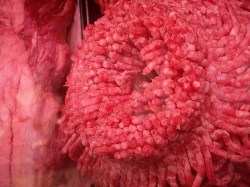
Cobalt123
In case you missed it last week, The New York Times ran an excellent article on a South Dakota company called Beef Products Inc., which makes a hamburger filler product that ends up in 70 percent of burgers in the United States.
To make a long story short: Beef Products buys the cheapest, least desirable beef on offer–fatty sweepings from the slaughterhouse floor, which are notoriously rife with pathogens like E. coli 0157 and antibiotic-resistant salmonella. It sends the scraps through a series of machines, grinds them into a paste, separates out the fat, and laces the substance with ammonia to kill pathogens.
The result, known by some in the industry as “pink slime,” is marketed widely to hamburger makers. The product has three selling points, from what I can tell: 1) it’s really, really cheap; 2) unlike conventional ground beef, which routinely carries E. coli, etc, pink slime is sterilized by the addition of ammonia; and 3) it’s so full of ammonia that it will kill pathogens in the ground beef it’s mixed with.
In short, Beef Products’ is peddling a solution–and a cheap one at that–to the beef industry’s embarrassing food-borne-illness problem (see my Meat Wagon series of posts for more on this topic). No wonder that burger purveyors from agribusiness giant Cargill to McDonald’s, from Burger King to your kid’s public-school cafeteria, snap up 60 pound blocks of pink slime and mix it into conventional ground beef at doses of up to 15 percent.
But as the Times story shows, the ammonia doesn’t always kill the pathogens in pink slime. Indeed, far from sterilizing a batch of burger mix, pink slime can actually add to the pathogen cocktail:
School lunch officials said that in some years Beef Products testing results were worse than many of the program’s two dozen other suppliers, which use traditional meat processing methods. From 2005 to 2009, Beef Products had a rate of 36 positive results for salmonella per 1,000 tests, compared to a rate of nine positive results per 1,000 tests for the other suppliers, according to statistics from the program.
Thus, of pink slime’s three chief selling points, only one holds up to scrutiny: it’s cheap.
Note that the information unearthed in this important Times is new only to the public; the fast-food industry, the USDA, and the school-lunch program have long known about pink slime’s less than stellar food-safety performance. Indeed, pressure from buyers may have contributed to the pathogen load–as The Times reports, complaints about an overpowering ammonia aroma forced the company to ramp down the dose of the sterilizing agent, which may have upped its susceptibility to salmonella, etc.
The pink-slime episode teaches us hard lessons about a food system that hinges on a few big companies churning out loads of cheap food. In a brilliant chapter in his book 2007 book The End of Food, Paul Roberts demonstrates how the profitability of large food companies depends completely on keeping costs as low as possible.
As companies scramble to slash costs, you get the rise of vast environmental calamities, like massive, feces-concentrating hog factories. Yet get human atrocities, like slavery in Florida tomato fields and systematic worker abuse in factory slaughterhouses. And you get public-health nightmares, like soaring diabetes rates tied to the rise of cheap, highly subsidized sweeteners.
The National School Lunch Program, which forces cafeteria administrators to feed students lunch for $2.68 per student per day, is a microcosm of our cheap food system. Two-thirds of that outlay goes to overhead and labor, leaving much less than a buck to spend on ingredients. No wonder the lunch program is such a massive buyer of pink slime–3.5 million pounds last year alone, the Times reports.
School lunch officials said they ultimately agreed to use the treated meat because it shaved about 3 cents off the cost of making a pound of ground beef…. In 2004, lunch officials increased the amount of Beef Products meat allowed in its hamburgers to 15 percent, from 10 percent, to increase savings.
Three cents off the cost of making a pound of ground beef. Under the severe fiscal austerity that school cafeteria administrators operate under, pinching those three pennies is a rational decision, even if it means subjecting children to ammonia-ridden slime that may contain pathogens.
For its part, the fast-food industry has reacted to the Times revelations, not by renouncing the use of pink slime but rather defending it. Accroding to Associated Press, “Fast-food chains McDonald’s Corp. and Burger King Holdings Inc. and agricultural conglomerate Cargill Inc. all use the [Beef Products] meat in their hamburgers. All said they’ll keep using the meat and that their products are safe.”
For them, billions of dollars in profits depend on pinching a few pennies per pound on inputs. As long as that economic structure remains in place, we can count on continued pathologies in the food system.


